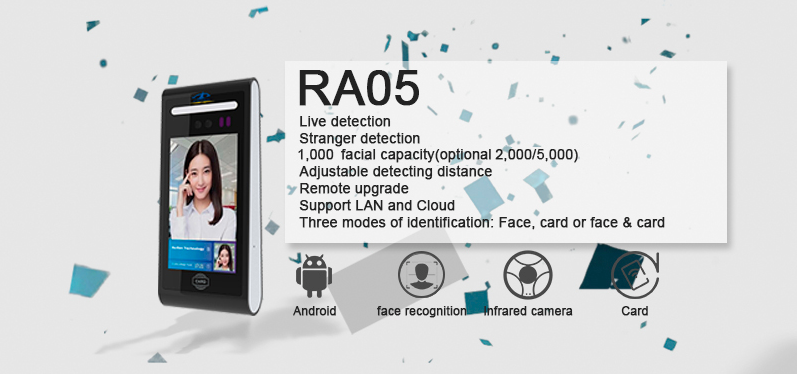Integrating RA05 Moving Face Recognition System with your Biometric Time Attendance and Access Control Solution

Facial recognition is already present in consumer technology: smartphones can be unlocked by simply showing your face; media apps like Facebook and Google Photos can detect who is in a photo. The next frontier for facial detection is surveillance — and it’s already available for enterprise-level security operations and in some home cameras.
RA05 Moving Face Recognition Camera can be implemented by organizations for biometric time attendance and access control purposes. This face recognition device can detect and track 5 persons simultaneously shown on the screen within a distance of 1.5 meters and the accuracy can reach 99.99%, less than 0.7 seconds.
How RA05 Moving Face Recognition Camera Works
You might be good at recognizing faces. You probably find it a cinch to identify the face of a family member, friend, or acquaintance. You’re familiar with their facial features — their eyes, nose, mouth — and how they come together.
That’s how RA05 face recognition device works, but on a grand, algorithmic scale. Where you see a face, this recognition technology sees data. That data can be stored and accessed. For instance, nearly 50 percent of American adults have their images stored in one or more facial-recognition databases that law enforcement agencies can search, according to a recent Georgetown University study.
So how does this device work for biometric time attendance and access control?
Step 1.
The device’s camera captures a picture of the employee’s facial image. The face may appear alone or in a crowd. The target image may show the subject looking straight ahead or nearly in profile.
Step 2.
Facial recognition software reads the geometry of the subject’s face. Key factors include the distance between their eyes and the distance from forehead to chin. The software identifies facial landmarks — one system identifies 68 of them — that are key to distinguishing to the subject’s face. The result: the subject’s facial signature.
Step 3.
The subject’s facial signature — a mathematical formula — is compared to a database of the subject’s face as is stored in the employee’s database.
Step 4.
A determination is made. The subject’s faceprint may match that of an image in a facial recognition system database to grant or deny access to the subject.
RA05 Moving Face Recognition Camera Key Features
● Live detection
● Stranger detection
● 1000 facial capacity(optional 2,000/5,000)
● Adjustable detecting distance
● Remote upgrade
● Support LAN and Cloud data storage
● Three modes of identification: Face, card or face & card
Conclusion
It is essential to keep your commercial facility highly protected by investing in the right security technology. One of the emerging advances in commercial security technology is facial recognition technology, integrated with the existing security tech that allows for saving on costs while also strengthening the level of security. Facial recognition devices can make use of biometric technology that analyzes the characteristics of a person’s face with images recorded from a surveillance video camera. This component of security provides instant alerts and feedback and leaves the subjects entirely unaware of the process. Any commercial facility looking for a great way to enhance security can find the right solution through integrating facial recognition, great for office buildings, hospitals, dispensaries, and so much more. Get in touch with Engsoft Valley Solutions today to learn how you can integrate face recognition technology into your existing biometric time attendance and access control system.

